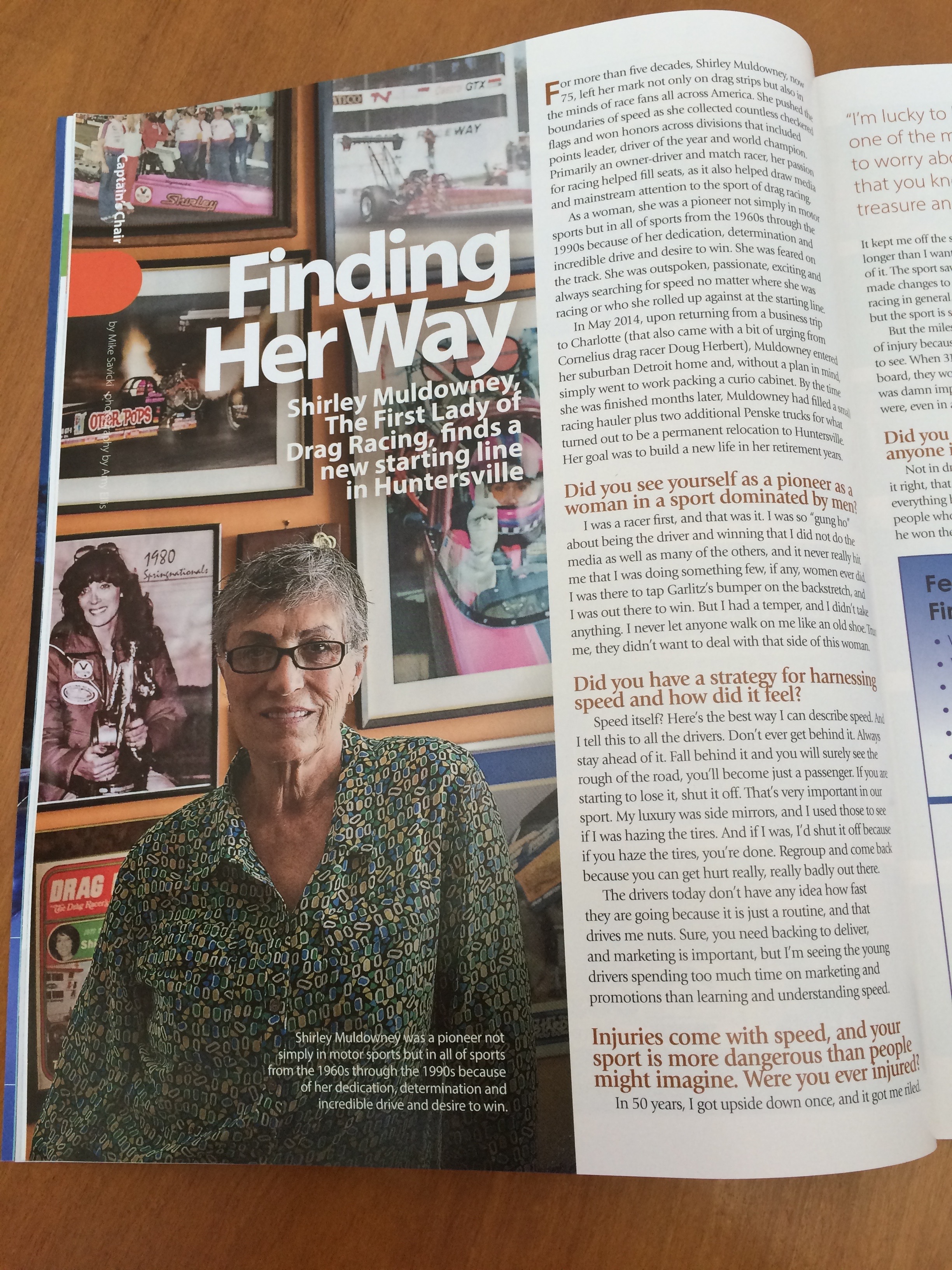Finding Her Way
Shirley Muldowney, The First Lady of Drag Racing, finds a new starting line in Huntersville
By Mike Savicki
For more than five decades, Shirley Muldowney, now 75, left her mark not only on drag strips but also in the minds of race fans all across America. She pushed the boundaries of speed as she collected countless checkered flags and won honors across divisions that included points leader, driver of the year and world champion. Primarily an owner-driver and match racer, her passion for racing helped fill seats, draw media and mainstream the sport of drag racing. And as a woman, she was a pioneer not simply in motor sports but in all of sports through the 1960’s – 1990’s because of her dedication, determination and incredible drive and desire to win. She was feared on the track, outspoken, passionate, exciting and always searching for speed, no matter where she was racing, or who she rolled up against at the starting line.
In May 2014, upon returning from a business trip to Charlotte (that also came with a bit of urging from Doug Herbert), Shirley Muldowney entered her suburban Detroit home and, without a plan in mind, simply went to work packing a curio cabinet. By the time she was finished months later, Muldowney had filled a small racing hauler plus two additional Penske trucks for what turned out to be a permanent relocation to Huntersville. Her goal was to build a new life in her retirement years.
Did you see yourself as a pioneer as a woman in a sport dominated by men?
I was a racer first and that was it. I was so “gung ho” about being the driver and winning that I did not do the media as well as many of the others and it never really hit me that I was doing something few, if any, women ever did. I was there to tap Garlitz’s bumper on the back stretch and I was out there to win. But I had a temper and I didn’t take anything. I never let anyone walk on me like an old shoe. Trust me, they didn’t want to deal with that side of this woman.
Did you have a strategy for harnessing speed and how did it feel?
Speed itself? Here’s the best way I can describe speed. And I tell this to all the drivers. Don’t ever get behind it. Always stay ahead of it. Fall behind it and you will surely see the rough of the road, you’ll become just a passenger. If you are starting to lose it, shut it off. That’s very important in our sport. My luxury was side mirrors and I used those to see if I was hazing the tires. And if I were, I’d shut it off because if you haze the tires, you’re done. Regroup and come back, because you can get hurt really, really badly out there.
The drivers today don’t have any idea how fast they are going because it is just a routine and that drives me nuts. Sure, you need backing to deliver, and marketing is important, but I’m seeing the young drivers spending too much time on marketing and promotions than learning and understanding speed.
Injuries come with speed and your sport is more dangerous than people might imagine. Were you ever injured?
In 50 years, I got upside down once and it got me riled. It kept me off the starting line for much longer than I wanted. But good came out of it. The sport saw what happened and it made changes. To the track, to the car, to drag racing in general. I hate that it happened, but the sport is safer, and that matters.
But the risk of injury was justified by the miles per hour because that’s what the fans wanted to see. When 315 (mph) came up on the board, they would go crazy because that was damn impressive no matter where you were, even in a Wednesday night race.
Did you look up to anyone in the sport?
Not in drag racing but the guy who did it right, that was Dale Earnhardt, Sr. I liked everything he was about. He thanked the people who needed to be thanked when he won the race regardless of who he was told to thank or promote. He was my hero. His license plate was on the front of my Mercedes for more than 10 years. I’ve been to one NASCAR race in my whole life – Charlotte, 1990 – and it was just to see him.
Do you have any special memories from your racing days?
For the majority of my career, I didn’t have a big sponsor deal or financial security and stability, so every race was special. I raced week to week then month to month whenever and wherever I could. I think about the track in Cordova, Illinois. It was kind of an off track as it was way out and away from a big city. It sits alongside the Mississippi River. I’d arrive at two o’clock and the grandstands were bleak and empty as far as you can see. But by eight o’clock that night, you couldn’t make elbow room. Now with match racing, you’d always race twice and the second race out there would go off after ten at night. The dew would have set in and it was like a skating rink but it was an incredible sight. I remember I was 62 years old and went out there and qualified. I laid down a 460-something at 319 (mph) and that was really something for Cordova. That’s a memory.
How has it been getting adjusted to life in the south?
The people down here, wow, they have such respect for their neighbors, they are so considerate. I’m discovering more and more as I increase my grid. The little shops and the furniture stores, they are so relaxing and therapeutic to me. I’m so glad I made the move. I’m finding my way.
This article was originally published in Currents Magazine.

